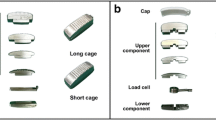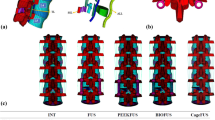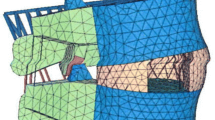Abstract
Interbody fusion cages are small hollow implants that are inserted into the intervertebral space to restore physiological disc height and to allow bony fusion. They sometimes cause clinical complications due to instability, subsidence or dislocation. These are basic biomechanical parameters, which influence strongly the quality of a fusion device; however, only few data about these parameters are available. Therefore, the purpose of the present study was to investigate the primary stabilizing effect of four different cervical fusion devices in in vitro flexibility tests. Twenty-four human cervical spine segments were used in this study. After anterior discectomy, fusion was performed either with a WING cage (Medinorm AG, Germany), a BAK/C cage (Sulzer Spine-Tech, USA), an AcroMed cervical I/F cage (DePuy AcroMed International, UK) or bone cement (Sulzer, Switzerland). All specimens were tested in a spine tester in the intact condition and after implantation of one of the four devices. Alternating sequences of pure lateral bending, flexion-extension and axial rotation moments (± 2.5 Nm) were applied continuously and the motions in each segment were measured simultaneously. In general, all tested implants had a stabilizing effect. This was most obvious in lateral bending, where the range of motion was between 0.29 (AcroMed cage) and 0.62 (BAK/C cage) with respect to the intact specimen (= 1.00). In lateral bending, flexion and axial rotation, the AcroMed cervical I/F cages had the highest stabilizing effect, followed by bone cement, WING cages and BAK/C cages. In extension, specimens fused with bone cement were most stable. With respect to the primary stabilizing effect, cages, especially the AcroMed I/F cage but also the WING cage and to a minor extent the BAK/C cage, seem to be a good alternative to bone cement in cervical interbody fusion. Other characteristics, such as the effect of implant design on subsidence tendency and the promotion of bone ingrowth, have to be determined in further studies.
Similar content being viewed by others
Author information
Authors and Affiliations
Additional information
Received: 15 July 1999/Revised: 28 March 2000/Accepted: 3 April 2000
Rights and permissions
About this article
Cite this article
Wilke, HJ., Kettler, A. & Claes, L. Primary stabilizing effect of interbody fusion devices for the cervical spine: an in vitro comparison between three different cage types and bone cement. E Spine J 9, 410–416 (2000). https://doi.org/10.1007/s005860000168
Issue Date:
DOI: https://doi.org/10.1007/s005860000168




